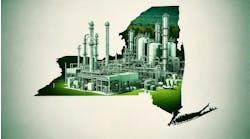Plant engineers generally believe their site's process heating and cooling systems are optimally designed. Often, they hesitate to respond to any opportunity to recover additional heat from existing processes. However, they typically welcome additional cooling that could help the process, such as from an absorption refrigeration system using wasted low-level heat. Generally, low-level heat from process streams is rejected to atmosphere either through air-fin coolers or cooling towers. It's also common to find flash steam rejected at low pressure levels. Absorption refrigeration converts this waste heat into high-value refrigeration duty.
A multinational chemical company in Illinois that produces p-xylene, a commodity chemical commonly oxidized to terephthalic acid (PTA) and further refined to produce purified terephthalic acid, successfully added absorption refrigeration to its process to achieve energy efficiency. A fact sheet from the Office of Industrial Technologies, Energy Efficiency, U.S. Department of Energy goes into detail on what was done. Here're the highlights.
[Related: Make The Case For Energy Improvements, Part 1]
Recovery of p-xylene generally involves one of two competitive processes, namely, low-temperature crystallization and selective adsorption on a molecular sieve. When using low-temperature crystallization, approximately 60% of the total electricity consumed is used to run the refrigeration system, mostly with conventional compressors. The refrigeration system typically uses cascaded ethylene and propane or propylene refrigeration loops.
Ammonia absorption refrigeration can replace the propane or propylene loop, leading to savings of approximately 37% of the total electricity use or 19% of the total energy cost. The reduced electricity consumption also results in lower indirect CO2 emissions associated with electricity generation. Absorption refrigeration requires two units of heat input per one unit of refrigeration duty. However, the heat source for absorption refrigeration is free, because the low-temperature waste heat would be lost if not used.
Absorption refrigeration operates with high- and low-pressure regions, and also with vapor and liquid regimes. Ammonia evaporated at low pressure creates the refrigeration. The evaporation pressure determines the temperature, which can drop to as low as -45ºC. To reach this low temperature, multiple refrigeration loops are applied in a cascaded manner. Absorption refrigeration is suitable for the crystallization of p-xylene and ethylene condensation (earlier stages of the cascaded loops).
[Related: Make the Case For Energy Improvements, II]
The use of waste heat reduced the electricity consumption of p-xylene units by 30 to 40%, depending on the feedstock and the p-xylene recovery process. For a 400 KMTA (thousand metric tons per annum) p-xylene unit, estimated annual electricity savings are 4.5 megawatts, while reductions in indirect CO2 emissions are estimated at 41 KMTA.
Progress and Milestones
To ensure success, the project occurred in four stages:
1. Technical feasibility determination: A quick study by waste heat recovery experts and refrigeration system vendors revealed the technical feasibility and economic incentive of adding an absorption refrigeration system to the existing refrigeration loops. Generally, this step involves matching the available low-level heat to the process cooling or chilling needs upon converting through an absorption refrigeration cycle. An estimate of economic benefits and the preliminary project cost at this stage will help management decide to move forward.
2. Design development: Several options considering the field conditions of the existing set up of cooling loops were reviewed to select the optimal design for enhancing the performance of the cooling loops and the recovery of p-xylene. This step provides a better definition of project scope, helping management to decide to proceed further.
3. Detailed engineering design: Once the project scope is defined clearly, the plant obtained a design package with all necessary engineering details and firm quotes from vendors for the commercial unit and its auxiliaries. A more accurate economic analysis at this stage helps the management to allocate necessary funds and financial authorization to move forward.
4. Project execution phase: Relevant in-plant personnel, who worked with partners to procure project components and construction contractors to complete the project within the cost and time, were given project management responsibility.
Gate reviews were conducted at the end of each stage before passing to the commissioning and operational phase. Upon successful completion, this multinational chemical company is considering commercializing this process. For further details on this specific project, contact [email protected].
Editor's Note: Have something to say about this column? You can Reply to it below. You must be logged in first. We'd love to hear your feedback.



